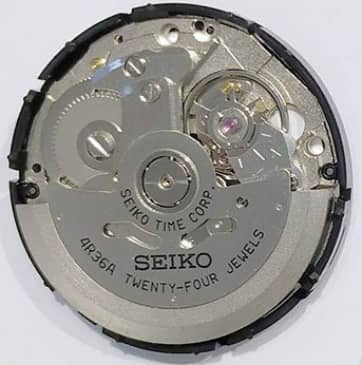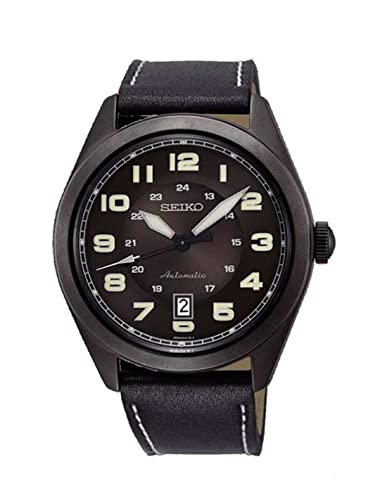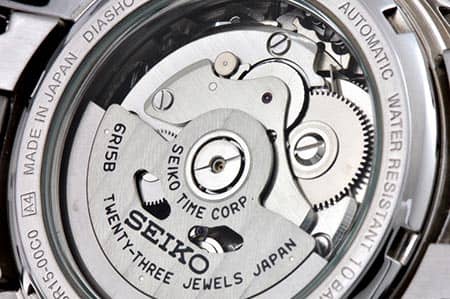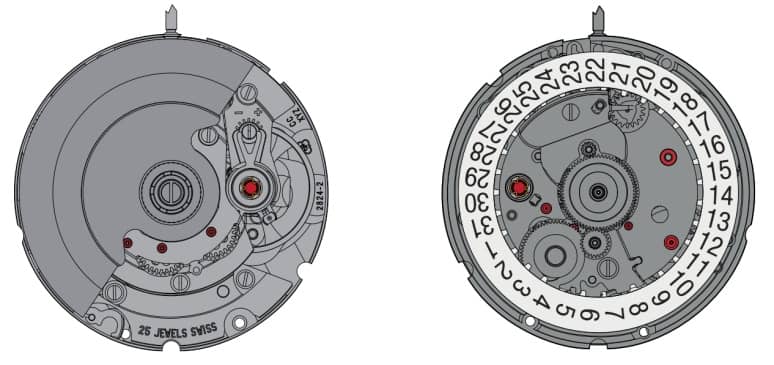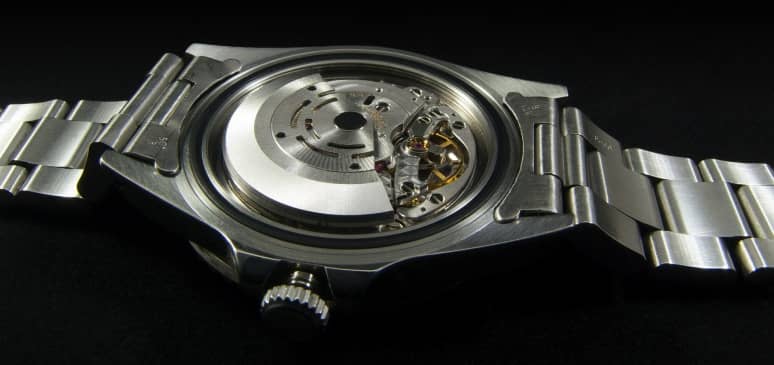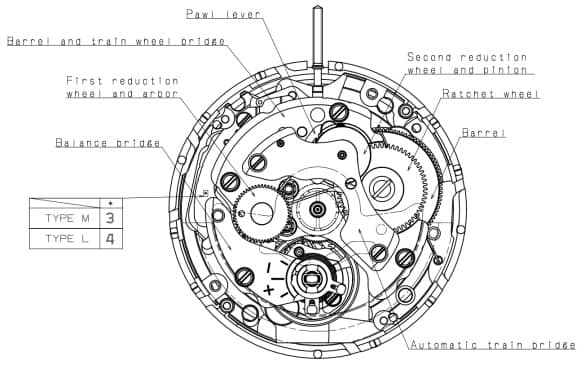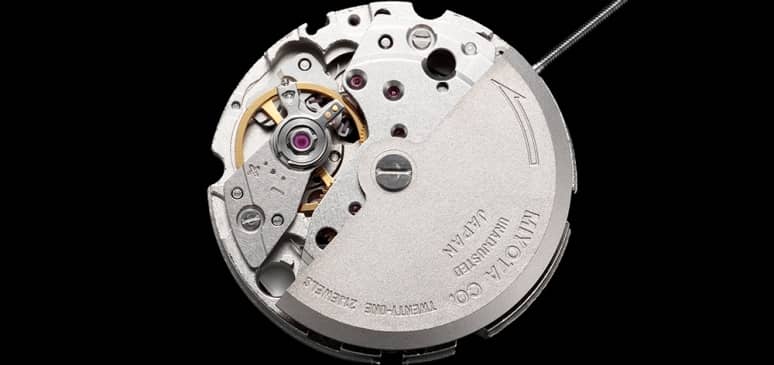The Seiko 4R36 is one of the most recent movements from the Japanese firm and is also one of the most commonly used in their watches currently.
Called to be the successor of the legendary 7S36, the 4R36 is a technically more advanced caliber in terms of specifications but equally budget-friendly.
An automatic movement that now also integrates the requested functions of hacking seconds and manual winding in line with other current calibers.
In this post, we will take a complete look at the features of the Seiko 4R36 and compare it with other calibers in the same price range to determine its quality.
- Carcasa de acero inoxidable
- Correa de metal con cierre desplegable y barra de seguridad con pulsador
- Cristal Hardlex (cristal mineral endurecido de la superficie)
- Resistente al agua hasta 100 metros
- Ø 43,0 x 13,0 mm
Índice de contenidos
✚ Seiko 4R36 – Technical specifications
| Manufacturer | Seiko |
|---|---|
| Origin | Japanese |
| Model | 4R36 |
| Year of release | 2011 |
| Movement | Automatic |
| Jewels | 24 |
| Vibration frequency | 21,600 vph |
| Power reserve | 40 hours |
| Dimensions | 27.4 mm x 5.32 mm (Diameter x Depth) |
| Precision | +45 ~ -35 seconds per day |
| Functions | Hour, minutes, and seconds on central hands, and calendar |
| Hacking seconds | Yes |
| Manual winding | Yes |
✚ 4R36 in detail
The Seiko 4R36 caliber has been on the market since 2011 when it was released to replace the 7S36, one of the most reliable and respected movements from the brand, although somewhat outdated by now.
In fact, they are very similar in technical terms, but the 4R36 incorporates the requested functions of hacking seconds and manual winding.
Like its predecessor, the 4R36 is an automatic movement with a bidirectional rotor based on the Magic Lever system and Diashock anti-shock protection.
This means it can generate energy when the rotor moves in both directions and is resistant to drops and impacts. It is commonly used in sports and diving watches.
It also beats at 21,600 vph and has 24 jewels, which ensures greater long-term durability with minimal maintenance.
The regulator is based on the Etachron system, allowing for easier adjustment of the balance spring and the possibility of achieving greater precision than what the manufacturer specifies.
➤ Precision
Regarding its precision, the official data from the manufacturer indicates +45 ~ -35 sec. / day, although in practice, it often performs much better.
When a manufacturer sets a precision range, it is more of a classification to position the movement, which usually turns out to be more accurate.
Typically, it is more likely to fall within the range of +- 15 sec. per day, but with a little more payment for proper adjustment by a watchmaker, even better values can be achieved.
Keep in mind that these are mass-produced, budget-friendly movements that don’t receive special attention during adjustment, but their design allows for post-adjustment without much complication.
➤ Power Reserve
The power reserve is around 40 hours when the mechanism is fully wound, either manually or by the natural movement of the wrist.
Thanks to the manual winding feature, it is possible to keep the watch running even when not wearing it, making this feature highly appreciated among collectors.
➤ Watches that use it
The 4R36 is an exclusive movement for Seiko and, therefore, can only be found in watches from the brand, especially in sports and diving models.
In other brands, you may find the NH36, a practically identical variant that Seiko manufactures for third parties, but it is not the 4R36 itself.
You can find this mechanism mainly in divers from the Prospex series, in the sports-oriented 5 Sports line, and in some dressier Presage models.
✚ Seiko 4R36A and 4R36: What is the difference?
There is no difference as they are the same movement. The letter “A” in Seiko 4R36A simply indicates that it is the first version of the caliber.
If more versions appear in the future (e.g., 4R36B, 4R36C…), there could be differences with the “A” model, as they would be updates to the movement.
✚ Seiko 4R36 vs NH36
Basically, they are the same mechanism, so there are practically no differences between them. The NH36 is nothing more than the version of the 4R36 that Seiko manufactures for other brands.
As with the Seiko NH35 and the 4R35, the NH36 is just a 4R36 without the Seiko logo and manufactured by one of its subsidiaries: SII (Seiko Instruments Inc).
| Model | 4R36 | NH36 |
|---|---|---|
| Movement | Automatic | Automatic |
| Jewels | 24 | 24 |
| Vibration frequency | 21,600 vph | 21,600 vph |
| Power reserve | 40 hours | 41 hours |
| Dimensions | 27.40 x 5.32 mm | 27.40 x 5.32 mm |
| Precision | 35 ~ +45 sec / day | -20 ~ +40 sec / day |
| Hacking seconds | Yes | Yes |
| Manual winding | Yes | Yes |
The only notable difference between the two is that the NH36 has a better precision rating, although in practice, there may not be a significant difference between the two.
Both movements offer the same adjustment possibilities and in the hands of a skilled watchmaker, they can be equally accurate.
✚ 4R36 vs 4R35

The main difference between these two movements is that the 4R36 displays the day of the week along with the date number.
Apart from that, they are exactly the same, although the 4R35 has one less jewel, which does not affect any other specifications.
| Model | 4R36 | 4R35 |
|---|---|---|
| Movement | Automatic | Automatic |
| Jewels | 24 | 23 |
| Vibration frequency | 21,600 vph | 21,600 vph |
| Power reserve | 40 hours | 40 hours |
| Dimensions | 27.40 x 5.32 mm | 27.40 x 5.32 mm |
| Precision | 35 ~ +45 sec / day | 35 ~ +45 sec / day |
| Hacking seconds | Yes | Yes |
| Manual winding | Yes | Yes |
✚ 4R36 vs 7S36

The most notable difference between these two mechanisms is that the 7S36 is older and does not have the coveted functions of hacking seconds and manual winding.
However, this does not necessarily mean that it is inferior, as being an automatic movement, it does not require manual winding, and stopping the second hand is only relevant for more precise time setting.
The Seiko 7S36 has been one of the most reliable and reputable movements from the brand for years, but the lack of these basic functions makes it somewhat outdated now.
| Model | 4R36 | 7S36 |
|---|---|---|
| Movement | Automatic | Automatic |
| Jewels | 24 | 23 |
| Vibration frequency | 21,600 vph | 21,600 vph |
| Power reserve | 40 hours | 41 hours |
| Dimensions | 27.40 x 5.32 mm | 27.40 x 4.90 mm |
| Precision | 35 ~ +45 sec / day | -25 ~ +35 sec / day |
| Hacking seconds | Yes | No |
| Manual winding | Yes | No |
✚ Seiko 4R36 vs 6R15
The Seiko 6R15 is a movement that belongs to a higher segment, and this is clearly reflected in its technical specifications.
On one hand, it has a higher power reserve, and on the other, it operates in a better precision range according to the manufacturer’s classification.
The 6R15 is also slightly more expensive, and thus it is usually found in Seiko watches with higher price points than those with the 4R36.
| Model | 4R36 | 6R15 |
|---|---|---|
| Movimiento | Automatic | Automatic |
| Joyas | 24 | 24 |
| Frecuencia de vibración | 21.600 vph | 21.600 vph |
| Reserva de marcha | 40 horas | 50 horas |
| Dimensiones | 27,40 x 5,32 mm | 27,40 x 5,25 mm |
| Precisión | 35 ~ +45 seg / día | -15 ~ +25 seg / día |
| Parada de segundos | Si | Si |
| Remonte manual | Si | Si |
✚ Seiko 4R36 vs ETA 2824-2
As shown in the table, the ETA 2824-2 is vastly superior in all aspects, which is normal considering that it is a Swiss movement and considerably more expensive.
The main difference lies in precision, as the 2824-2 has several levels of adjustment, all of which are superior to the 4R36. In fact, it can be adjusted to chronometer values and meet the COSC certification.
Additionally, it operates at 28,800 vph, which means the second hand moves more smoothly and faster from second to second.
In any case, both are excellent movements, well-known and reliable, each in their respective price segments.
| Model | 4R36 | ETA 2824-2 |
|---|---|---|
| Movement | Automatic | Automatic |
| Jewels | 24 | 25 |
| Vibration frequency | 21,600 vph | 28,800 vph |
| Power reserve | 40 hours | 38 hours |
| Dimensions | 27.40 x 5.32 mm | 25.6 x 4.6 mm |
| Precision | 35 ~ +45 sec / day | +-12 / +-7 / +-4 sec. day |
| Hacking seconds | Yes | Yes |
| Manual winding | Yes | Yes |
✚ Time and Date Setting
The crown allows for easy adjustments of the time and date, as well as manual winding of the movement.
- Time: Pull the crown out to the second click (2 clicks), then rotate it clockwise or counterclockwise to set the hands to the desired position.
- Date: Pull the crown out to the first click (1 click). Turning it counterclockwise adjusts the day of the week, and turning it clockwise adjusts the date.
- Manual winding: Rotate the crown clockwise without pulling it out.
Related
Relojes.Wiki participates in the Amazon EU and Amazon US Associates Program, an affiliate advertising program designed to provide websites with a means to earn advertising fees by advertising and linking to Amazon.es, Amazon.com and Amazon.co.uk
As an Amazon Associate, I earn from qualifying purchases. More info.
Last update of links and images on 2025-12-18.


